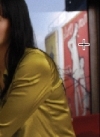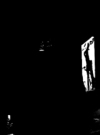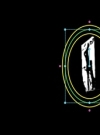A Basic HSL Qualification Workflow
This section shows you the basic procedure you'll use for doing HSL Qualification using nearly any color correction application. The exact UI may differ, but these general steps remain the same.
First, Define the Basic Key
There are two ways to begin creating a secondary key.
In the first method, you click the Select Color button, and then click somewhere in the Canvas with the eyedropper to select a primary Hue, Saturation, and Luma value. Depending on the HSB value of the pixel you clicked, Final Cut Pro, for example, turns on (checks), one or more of the qualifiers and sets them to the values found within that pixel. If you click a white pixel, the program may turn on the Luma qualifier only. If you click a red pixel, on the other hand, all three qualifiers are likely to turn on.
The second way to begin a key is simply to start adjusting one of the qualifier controls directly, manually dialing in the ranges of values you want to isolate.
Either method is appropriate, although with practice, you'll find that single-component keys tend to be faster to pull if you know exactly which color component you want to isolate, whereas keys on subjects that naturally combine all components can be tricky. For example, the shadows and highlights of the skin tones on someone's face are always a mix of a variety of hues, luma levels, and saturation, which really requires an eyedropper/image sampling selection to get started.
In the following example, the consensus in the suite is that the red poster that's reflecting in the window behind the woman in the green shirt is too distracting (Figure 4.17). We'll take a look at how to quickly isolate the offending object and use the resulting matte to create the necessary correction to address this.

Figure 4.17 The image with a single primary correction.
HSL Qualification makes isolating the poster really easy.
- Click your color correction application's eyedropper/Color Picker button to get into the mode for sampling a color from the image, either in your application's canvas/viewer, or on your broadcast display.
- Using whatever tool appears (an eyedropper cursor, red crosshairs, a bounding box), sample values from the image by doing one of the following:
- Click once to sample the initial value with which to create the key. Then, using a second tool (such as the + button in DaVinci Resolve), click elsewhere to expand the sampled region that contributes to the matte (Figure 4.18).

Figure 4.18 Using crosshairs to sample the color from a subject for isolation.
- In other applications, you can simply click and drag to immediately sample a wide range of values with which to create a matte.
When you release the mouse button, a few things happen. First, the matte you've just created should become visible. For example, in DaVinci Resolve, the icon of the node containing the new qualifier settings updates to show the new matte.
In other applications, dedicated matte preview areas may display the new matte, or the canvas/viewer may update with a preview display of the matte so you can judge how successful your sample was (Figure 4.19).

Figure 4.19 A preview display of the matte.
Finally, the individual qualifier control parameters update to reflect the range of values you've sampled (Figure 4.20).

Figure 4.20 The updated individual qualifier control parameters in DaVinci Resolve.
- Click once to sample the initial value with which to create the key. Then, using a second tool (such as the + button in DaVinci Resolve), click elsewhere to expand the sampled region that contributes to the matte (Figure 4.18).
- To prepare for the next stage, switch your color correction application to display the matte, if is hasn't already done so automatically.
Refine the Key
With any key you pull, you'll rarely get it perfect with the very first drag of the eyedropper. In the best cases, there may be a bit of fringe around the edges that you don't want, as in the current example. In less ideal circumstances, you'll be attempting to isolate a difficult range of color (isolating swimsuit skin tones when the actors are surrounded by beige sand can be challenging), or working with video that has limited chroma information, making clean edges difficult.
-
You can sample another part of the image to add it to the matte. For example:
- In DaVinci Resolve you simply click the + button next to the eyedropper and then click to sample another range in the viewer.
- In Apple Color, you click the eyedropper again and then Shift-drag to expand the selection.
Trying this with our image lets us solidify the poster matte while at the same time adding other parts of the image that we don't necessarily want to include (Figure 4.21).

Figure 4.21 The matte after adding to the selection. More of the poster is included, but some of the woman's dress at the far left is included as well, which we don't want.
At this point, we're probably going to have to turn to the individual qualifier controls to make more specific adjustments to most successfully fine-tune the matte.
- If your application's qualifiers work using the "center adjustment" model, a good tip for figuring out if manipulations to any of the qualifiers will do you any good before you start manipulating them, is to wiggle the center of each qualifier to the left and right while watching the matte. If the matte changes dramatically, then chances are that manipulating that qualifier will do you some real good. If the matte changes only slightly, then your initial sample probably got the range about right, and you can move on.
-
Once you've identified which qualifiers you need to adjust, carefully widen and/or re-center their inner range handles/parameter to highlight as much of the subject you're trying to isolate with white (or color, if you're viewing the matte in color/desaturate mode), while excluding as much of everything else as you can with black.
Adjusting the qualifiers one by one is a good policy, and I usually start with Hue, since that almost always does me the most good. For this example, I made the following adjustments:
- Hue: I increased the width of the isolated range of hue.
- Saturation: I increased the range of isolated saturation, shifting it asymmetrically to include less saturated values.
-
Luma: No adjustment to luma was necessary to improve the key (Figure 4.22).

Figure 4.22 Adjustments to the individual qualifiers in DaVinci Resolve to solidify the matte.
This had the effect on the key shown in Figure 4.23.

Figure 4.23 The key after adjustments to the individual HSL qualifiers.
At this point, several edge details of the woman at the left are being included in the matte. Fortunately, the unwanted details are far away from the poster we're trying to isolate, so we'll ignore all that for now to see what we can get away with.
Manipulate the Key Using Blur
Once the general key has been defined and you feel that you've made it as good as you can using the individual qualifiers, it's time to refine the matte using some filtered post-processing in the form of blur and edge processing.
The key created by any HSL keyer is simply a grayscale image, and these parameters apply a filter-style effect to this image to help you make difficult keys more usable by minimizing rough edges, eliminating small holes in the matte (if necessary), managing noise and grain, and subduing edge chatter.
At the very least, every grading application has a blur parameter with which you can feather the matte, which can be a huge help in cases where fringe in the matte is hard to eliminate. It also comes in handy with highly compressed media that may exhibit blocky edges in the matte.
For this example, adding a small amount of blur helps to take the edge off of the matte itself (Figure 4.24).

Figure 4.24 The Blur parameter softens the matte just a little bit, to minimize aliasing.
Don't overdo matte blurring or you'll end up with either a halo around the area you're keying once you start to make your correction, or you'll unwittingly shrink the key so that original color will remain at the edge of the keyed subject after the correction.
Use a Shape/Power Window to Crop Unwanted Features from the Matte
Often, unwanted portions of an image get included in a key you're trying to pull because the chroma or luma values are simply too close to the colors you're trying to isolate, with one of two results:
- You have good isolation but a crummy matte.
- You've got a great matte but it's too loose, keying other parts of the frame that you don't want to include.
You can fiddle with the qualifiers all you want, but you just can't pull a completely clean key. In these situations, the best thing to do is to turn on whatever shape/Power Window control is available in your grading application, and use it as a garbage matte (to use compositing terminology) to exclude the areas of the image you don't want to be included in the key.
Applications do this differently, but the general idea is that whenever you use both HSL Qualification and a mask/shape/vignette/Power Window within a single secondary/scaffold/strip/grade, the two will be combined so that the only keyed areas that are preserved are those appearing within the shape.
- Turn on the type of shape that will best isolate the portion of the key you want to preserve (for more details on using shapes/Power Windows, see Chapter 5).
- Make sure you feather the edge of the shape so there are no harsh edges should you need to crop the key really closely.
- Reposition the shape to isolate the desired portion of the HSL key (Figure 4.25).

Figure 4.25 Cropping out unwanted portions of the key using a shape/Power Window.
The resulting shape-limited matte is now suitable for making our correction. At this point, all we need to watch out for is whether or not it's necessary to animate or motion track the shape so that it follows the subject if it or the camera is moving (both of which are covered in Chapter 6).
So, if shapes are so handy, why not just use a shape all by itself? Because, as you can see in Figure 4.25, shapes aren't nearly as specific and discriminating as a good key. In this example, the key conforms well to the red portion of the poster, while leaving the figures within alone.
If we were to try using a custom shape/Power Curve, it would require a lot of drawing, and we'd risk needing to rotoscope the resulting shape to match a moving camera.
It's much more detailed and faster to key the poster, even though we're including other parts of the image by accident, and then limit the key using this simple oval shape/Power Window, tracking it to generally follow the subject if there's motion.
Make Your Correction
Now that we've refined the matte to our satisfaction, we're ready to make an adjustment. The spectacular example would be to change the red poster to another vivid color, but the whole point is to make the poster less noticeable, so we'll do the opposite of what we usually do, reducing contrast and fading the color to make it as much of an indistinguishable part of the background as we can. Here are the steps you need to take:
- Turn off the matte preview so that you can see the actual image.
- Eliminate the objectionable red by desaturating it until it's a muted, pale color, and then rebalance the Midtones/Gamma color to be bluish rather than reddish.
- Lastly, reduce contrast by raising the Shadows/Lift contrast control, while lowering both the Midtones/Gamma and Highlights/Gain controls, doing your best to make the poster as unnoticeable as possible (Figure 4.26).

Figure 4.26 The final effect, the poster in the reflection is muted, no longer drawing attention to itself.
And the correction is complete.
This is but one of the myriad uses of the HSL Qualifiers. In the next section, we'll take a look at what to do when you've got a hard-to-key shot, for which an HSL Qualification is your best bet.